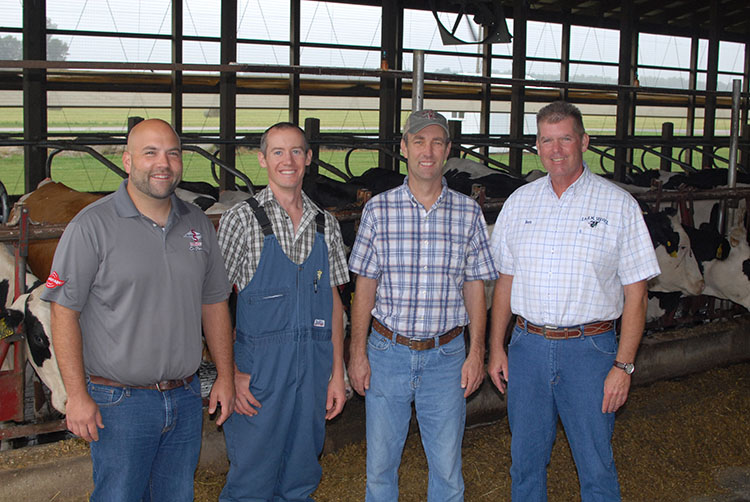
“We use PC Dart for our record keeping. We record all calvings, breedings, and drying off,” noted Ed Pfeifer regarding his family’s Bucyrus, Ohio, farm that won Platinum honors in this year’s Dairy Cattle Reproduction Council’s ninth annual awards competition. “Heats are not recorded because that will kick cows out of the program the way we are set up.
“Cows are entered weekly into the appropriate synch program. We then print out a weekly list for protocols and timed A.I. It also generates our pregnancy checklist and recheck list for cows bred 90 days,” Pfeifer went on to say.
All six of this year’s Platinum winners of the Dairy Cattle Reproduction Council’s awards share additional insight in this Hoard’s Dairyman Intel as well as the Round Table found on pages 707 to 709 of the November issue of Hoard’s Dairyman. This year a record 128 herds were nominated for the award from 18 U.S. states and Canadian provinces.
Here are additional responses to the question, “How do you keep track of heats, breeding records, and so forth?”
Copperhill Farm, Fairfax, Vt.: We use computer records as well as paper records to keep track of all of our reproduction data. Heats and breedings are entered into Dairy Comp by the person who breeds the cow. We have specific breeding codes to determine under what scenario she was bred. It is important to keep track of that so we know exactly which synch protocol or action is most effective. (We have 11 breeding codes.)
Along with the computer records, we have a binder with a computer-aided Microsoft Excel spreadsheet. We write down the date, cow number, technician, bull used, and then check the following boxes that tell more about this cow: First service, on cycle, standing, riding, chalk, pregnancy status, and notes about the insemination. Having paper records helps when you need to look back and see exactly why you bred that cow.
All of our ovsynch protocols are in paper form. On the top of the paper, we have the next protocol listed with the date due to be given next to it. Below are the lists of cows. When a cow is bred off of that list from the second prostaglandin or natural heat after the VWP, the date will be written next to the cow’s number and it will be highlighted blue.
When making protocol lists you see the cow that has been highlighted so you know she has been bred and no longer needs any shots. This gives you a good visual of how your presych program is working, how many cows are getting bred off prostaglandin, and how many are going through a full ovsynch.
Dunlea Dairy Farm, Coudersport, Pa.: We use Dairy Comp 305 and only record breedings. We do use Dairy Comp 305 to generate all protocol lists for prostaglandin. Larry Spencer records the breedings. Margarito Salinas gives all the reproductive protocols.
Pine Hollow Dairy, Locke, N.Y.: We use Dairy Comp 305 as our record keeping system. Our on-farm technicians enter the breeding data on the computer after breeding a cow. We have commands written that generate the lists of cows for us to enroll in the synchronization programs. Accurate data entry is critical to the success of our program.
Seidl Mountain View Dairy, Luxemburg, Wis.: All records are done in Dairy Comp 305 and entered by Steve Paider, the dairy manager.
SunBurst Dairy, Belleville, Wis.: We keep track of heats in a notebook. A majority of information is on paper and then entered into our computer. All information is entered as events take place. Our goal is to have up-to-date information. The information is recorded by either Yogi Brown or Alfonso Perdomo into Dairy Comp. Information also is utilized on BoviSync system. We record all health information including the pregnancy enhancement program, technician, and reinsemination. Our system also imports milk production information (DHIA) and matings.
Before animals are inseminated, they are evaluated on current and past issues, milk pounds/components, SCC, days open, and so forth. A decision is made from the information of what types of sire we use or the direction we take.
This Hoard’s Dairyman Intel article is part of an eight-part series detailing top reproduction tips from the Platinum-winning herds for the ninth annual Dairy Cattle Reproduction Council awards competition.
Click here to view previous reports from this DCRC series:
They get postfresh cows off to a great start
How they handle problem-breeding cows
Sexed semen has a role on some dairies
Nutrition sets up reproductive success
To comment, email your remarks to intel@hoards.com.
(c)Hoard's Dairyman Intel 2016
December 5, 2016








